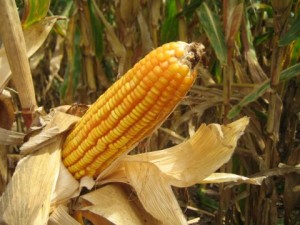15 December 2010
Too much fertilizer is bad for biofuels
Posted by mohi

Excess fertilizer for corn crops hurts biofuel production as well as the environment. Photo courtesy of USDA
Like fast food junkies who pile on extra fries because it’ll only cost a couple cents more, growers in the U.S. dump tons of fertilizer on their fields because it’s cheap and the extra food can’t hurt their crops, right? Well, for farmers raising corn for the food and biofuel business that might not be such a good idea.
In the session B23D “Environmental Aspects of Bioenergy Production II Posters,” Morgan Gallagher of Rice University outlined the problems, and her solution, for excess fertilizer on corn crops.
With government and industry stampeding towards biofuels, the market for corn is growing. More acreage is devoted to raising corn for fuel, and fertilizer and water usage increase accordingly.
Corn-based biofuels are produced in two ways. One method makes fuel from corn kernels–more specifically, the carbohydrate residing in the kernels. The second method derives fuel from fiber-heavy parts of the plant like the stalks and leaves. Biofuel corn grown for their kernels produce the highest yields when they aren’t short on nitrogen (fertilizer), said Gallagher.
But the extra fertilizer runs off into the environment and can cause all kinds of problems. Large inputs of nitrogen into waterways can result in “dead zones” downstream–areas of a river or ocean devoid of oxygen and life. Nitrogen can also percolate into our groundwater, creating potential health hazards for humans.
Despite this, kernel-based biofuels are heavily produced because they are easier to make–the stalks and leaves used in making biofuels from the fibrous parts of corn are high in a material called lignin, which enzymes used in biofuel production find difficult to break down.
When Gallagher looked at how lignin concentrations reacted to differing amounts of fertilizers, she found that the more fertilizer she added, the higher the lignin concentration. When she looked at how the carbohydrate content of corn–the energy source of the biofuel–reacted to increasing amounts of fertilizer, she found that carb levels plateaued at relatively low levels, around 67 kilograms of nitrogen fertilizer per hectare.
Gallagher said that the recommended amount of fertilizer at her field site is about 110 kilograms of nitrogen per hectare. But it’s not unusual for farmers to apply more to their fields in response to economic pressures to maximize their yields. But Gallagher showed that the only things farmers do for biofuel crops by adding so much fertilizer is to increase the lignin content of their corn. If they tried to use the leftover parts for biofuel production, they’d have a harder time of it.
If farmers wanted to use a single harvest of corn for both food and fuel, a two for one deal, then Gallagher said a better strategy would be to limit fertilizer usage. In this case, economically, less is more. Farmers would save money on fertilizer costs and it would also help alleviate some of the problems of excess fertilizer because farmers wouldn’t have to plant double the acres for the same amount of food and fuel.
Whether habits change in how farmers fertilize their crops remains to be seen. As we all know, sometimes it’s really hard to say no to extra fries.
–Jane Lee is a science communication graduate student at UC Santa Cruz










 GeoSpace is a blog on Earth and space science, managed by AGU’s Public Information staff. The blog features posts by AGU writers and guest contributors on all sorts of relevant science topics, but with a focus on new research and geo and space sciences-related stories that are currently in the news.
GeoSpace is a blog on Earth and space science, managed by AGU’s Public Information staff. The blog features posts by AGU writers and guest contributors on all sorts of relevant science topics, but with a focus on new research and geo and space sciences-related stories that are currently in the news.